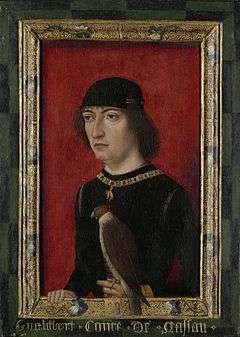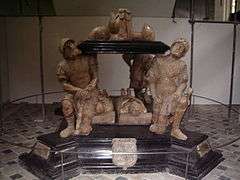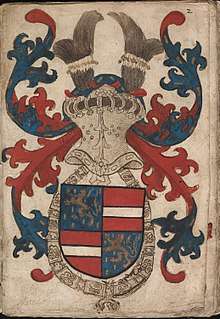Engelbert II of Nassau
Engelbert II of Nassau, Engelbrecht in Dutch (17 May 1451 – 31 May 1504), was count of Nassau and Vianden and lord of Breda, Lek, Diest, Roosendaal, Nispen and Wouw. He was a soldier and courtier, for some time leader of the Privy council of the Duchy of Burgundy and a significant patron of the arts.



Biography
Engelbert was born in Breda on 17 May 1451, the son of Jan IV of Nassau and his wife Maria of Loon-Heinsberg.[1]
On 19 December 1468 in Koblenz he married Cimburga van Baden, daughter of Charles I, Margrave of Baden-Baden.
Engelbert was lord of Breda between 1475 and 1504. In 1472 he concluded a treaty with his brother Jan V of Nassau-Vianden-Diez in which he received the possessions West of the Rhine. Charles the Bold made him a knight in the Order of the Golden Fleece, at the age of 22, in 1473.[1]
After the death of Charles the Bold, Engelbert entered in the service of Maximilian I, Holy Roman Emperor, who had married Charles's daughter Mary of Burgundy.
In 1479, he commanded troops during the Battle of Guinegate and during the suppression of a rebellion at Bruges.[2]
In 1487, he was captured by the French during the Battle of Béthune, and released for an "enormous" ransom 2 years later.[1] In 1496 he was appointed stadtholder of Flanders and by 1498 he had been named President of the Grand Conseil.
In 1501, Maximilian named him Lieutenant-General of the Low Countries.[2] From that point forward (until his death in 1504) Engelbert was the principal representative of the Habsburg Empire to the region.[1]
Death
Engelbert died on 31 May 1504 in Brussels and is buried in the Grote kerk in Breda. He had no legitimate children and appointed his nephew Henry III of Nassau-Breda as his successor. Engelbert had two illegitimate children: Engelbrecht and Barbara.
Engelbert II of Nassau in art
Engelbert's portrait by the Master of the Portraits of Princes, can be found in the Rijksmuseum Amsterdam. He was one of the last important patrons of Flemish illuminated manuscripts, and commissioned perhaps the most sumptuous manuscript of the Roman de la Rose, British Library Harley MS 4425, which has 92 large and high quality miniatures, despite a date around 1500; the text was copied by hand from a printed edition. These are by the artist known as the Master of the Prayer Books of around 1500.[3] The Book of Hours of Engelbert of Nassau (Bodleian Library, Oxford, Ms Douce 219–220), of the 1470s or 1480s is another well-known manuscript.[4] It has been suggested that he commissioned The Garden of Earthly Delights by Hieronymous Bosch.[5]
References
- George Chastelain and the Shaping of Valois Burgundy: Political and Historical Culture at Court in the Fifteenth Century by Graeme Small (Boydell & Brewer, 1997)
- The Life and Times of William the Third, King of England, and Stadtholder of Holland: In Two Volumes (Volume 1) by Arthur Hill Trevor (1835)
- British Library
- T Kren & S McKendrick (eds), Illuminating the Renaissance: The Triumph of Flemish Manuscript Painting in Europe, cat. 18, Getty Museum/Royal Academy of Arts, 2003, ISBN 1-903973-28-7 The Roman ms is cat. 120. see also the index for other mentions.
- Gerlach, P. (1969). "De Nassauers van Breda en Jeroen Bosch' De Tuin der Lusten". Brabantia. XVIII: 155–160.
External links
| Wikimedia Commons has media related to Engelbrecht II van Nassau. |
Engelbert II of Nassau Born: 17 May 1451 Died: 31 May 1504 | ||
| Regnal titles | ||
|---|---|---|
| Preceded by Rule of Emperor Maximilian I |
Governor of the Habsburg Netherlands 1485–1486 |
Succeeded by Rule of Emperor Maximilian I |
| Preceded by Rule of Philip the Handsome |
Governor of the Habsburg Netherlands 1501–1504 |
Succeeded by William de Croÿ |